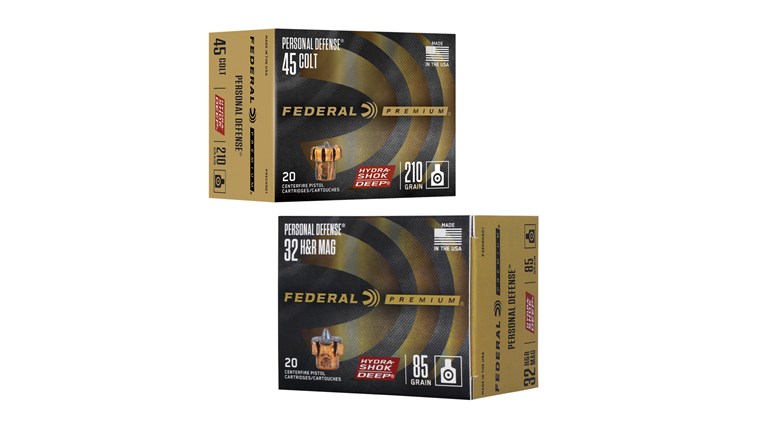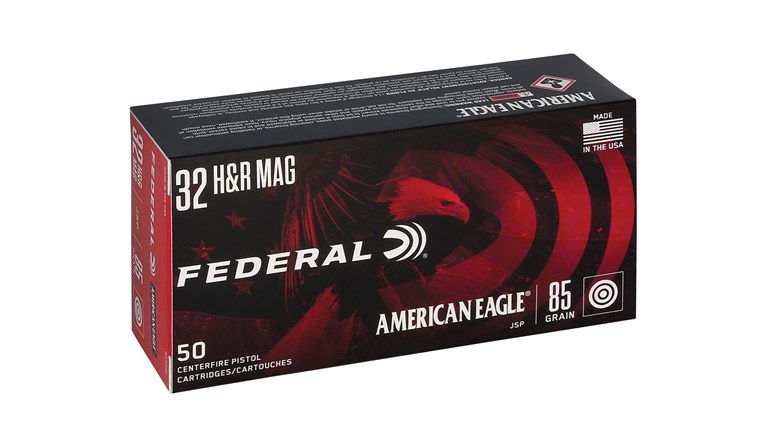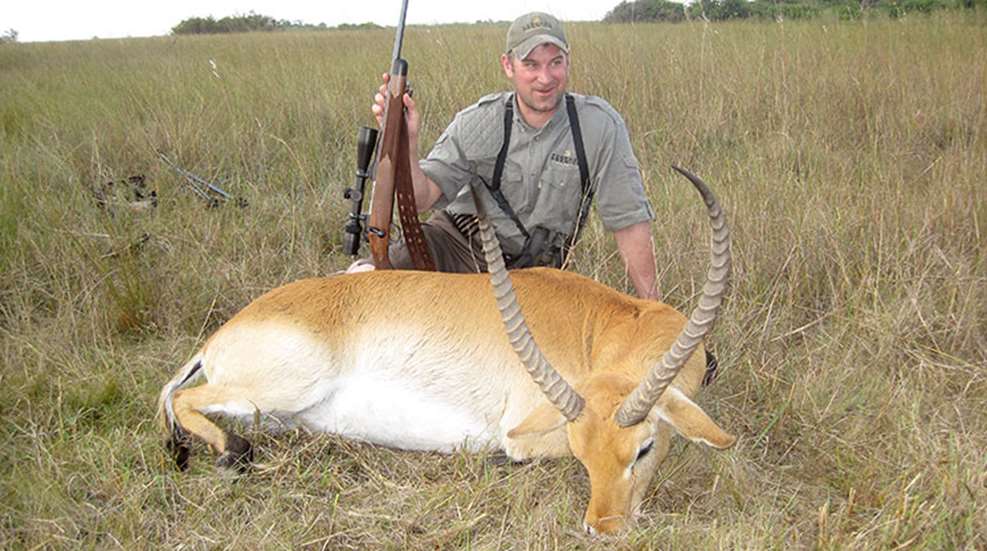
The thought crossed my mind that if a croc wanted to eat me, there wouldn’t be a whole lot I could do about it. Once I was past that I stopped worrying and was soon up to my belt in the tepid, tea-colored water. Even so, I still clenched my teeth (and other body parts) when an unseen something or another brushed my bare legs underwater.
If I believed Riaan, my PH—and I really wanted to—crocodiles probably weren’t the greatest threat anyway. Most of them were likely to be closer to the main river channel, where the water was deeper. Out on the floodplain, among the sprawling stands of papyrus the size of strip malls, hippos were the real danger. Two bulls grunting somewhere back in the tall reeds made it clear this swampy piece of land was their territory. Judging by the volume and frequency of their throaty warnings, they were prepared to defend it. The question was, were they worked up because of each other or because of us?
I glanced over my shoulder at Rick Stoeckel, one of the guys who calls the shots at Federal Premium Ammunition, who was also wet to the waist. We’d been in Namibia’s Caprivi Strip long enough to know we were standing smack in the middle of a hippo highway. And we’d heard enough stories about the havoc a 4,000-pound beast with tusks the size of 2x4’s can wreak to know the hippopotamus is not the hapless, harmless giant portrayed in cartoons. All muscle, hippos run over things blocking their way and throw in a few tusk gouges for good measure.
Rick just shook his head and let out a weak laugh. Neuroscientists say nervous laughter is not real laughter but instead a response to tension or anxiety. In that sense, wading through a channel carved into the floodplain by constant hippo traffic, with two likely commuters bellowing in the background, was a laughing matter. It reminded me of crossing a farmer’s bull pasture to reach the secret bass pond on the other side. I couldn’t help responding with a chuckle of my own. Come to think of it, the fact that my PH’s defining characteristic was a blue-and-green striped rugby shirt and not a battle-scarred rifle made the situation downright hilarious.
The risk was worth it. With the banks of the Cuando River at our backs, we had left the relative security of the boat to pursue a small herd of handsome antelope with lyre-shaped horns known as red lechwe. The Caprivi, a sliver of land in northeast Namibia sandwiched between Angola and Zambia to the north and Botswana to the south, is one of the few places in Africa where populations of lechwe (pronounced “letch-way”) occur naturally, making our stalk somewhat of a rare opportunity.
One of four lechwe subspecies, all of which are limited to a handful of river systems in southern Africa, the red variety gets its descriptor from its coppery coat. Rams weigh 200-250 pounds and have ringed horns that resemble those of a waterbuck, only smaller and with a more graceful curve. Unlike Rick and me, they are at home wading across the Caprivi’s floodplains and even swimming its bordering rivers. In fact they specialize in it, with elongated hooves that help distribute their weight when walking in muck and a greasy coat that repels water.
In contrast, Rick and I struggled. The footing underwater was squishy and uneven. Rotting clumps of grass not dislodged by the hippos caught our toes and caused us to stumble, splash and pray that we wouldn’t submerge our rifles. Sometimes one of my feet would land squarely atop an unseen tussock, bringing my leg above the knee out of the water and requiring a momentary balancing act before I could step or slide back into the depths. We tried to remain as quiet as possible, although I’m sure a few of the involuntary gasps I produced when something solid—was that scaly?—bumped my shins were quite audible. Luckily, the grass surrounding the channel was at our shoulders, and it concealed most of our approach from the lechwe grazing a good quarter-mile away.
We were soaked and sweaty and filled with the edgy feeling that makes hunting in Africa an addiction. Two days earlier I nearly stepped on a puff adder while tracking eland. A few days before that, Rick was charged by a cow elephant that his PH dropped at an uncomfortably close six paces. No one goes to Africa looking for trouble, but if you hang around in the bush long enough, some degree of it will likely find you. Over time, you may even start to enjoy the presence of danger. It’s part of the experience, and as a hunter you embrace it rather than shy from it like a tourist ensconced atop a double-decked tour yacht.
Plenty of visitors to the Caprivi come for a different kind of safari. We’d seen the extravagant lodges near the eastern tip of the Strip, on the banks of Zambia’s Zambezi and Botswana’s Chobe, which pamper those seeking trophy-quality photographs. These tourists observe the land and the wildlife, usually from behind a camera and safely aboard a big boat, but they rarely interact with it on the level of a hunter. To hunt the Caprivi, even for plains game like lechwe, you must be willing to accept a simultaneous status as prey. Skill with a rifle puts you near the top of the food chain, but not always at the very top. You hope to kill something without getting killed by something bigger—that’s life in the Strip for a predator, whether he walks on two legs or four. Non-hunters don’t get to experience that, and in most cases they wouldn’t want to anyway. Hunting Africa is much different than just seeing it.
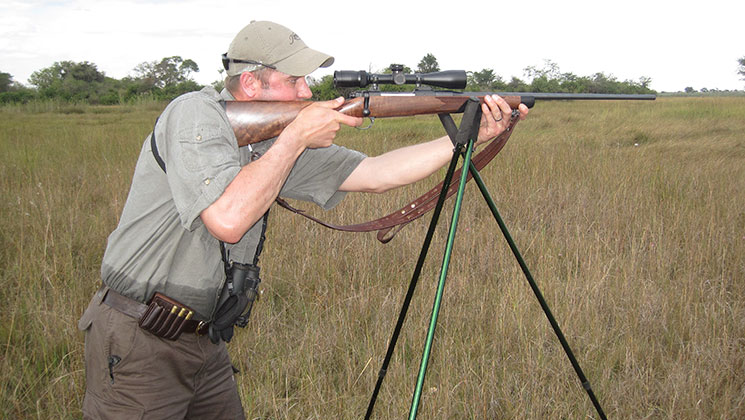
Standing in water that allowed only about a foot of visibility, I realized I would probably feel a croc before I saw it. If one clamped down on my knee and dragged me under, the .338 Win. Mag. clutched beneath my white knuckles would be of little use. To a crocodile, I was simply something to eat, and an easy meal at that. To a hippo, a slightly intruder. I respected that, even celebrated it, but at the same time I hoped I wasn’t pressing my luck.
Our fortune held as the channel gradually got shallower and eventually ended against a low, soggy bank. We crawled out of the depression partly because it was almost impossible to stand on the saturated ground without sinking up to our knees and partly because the only cover between us and the lechwe was waist-high grass. It looked like 350 yards or so still separated us from the larger of the two rams in the herd, but gauging distance across the floodplain was difficult. I reached for my rangefinder but discovered I had left it in the boat. Rick’s was there, too. We had to get closer.
A short crawl brought us to a wide, sandy ridge, if you could call it that. The difference in elevation between it and the spongy ground we had just covered was at most 2 feet, but it marked an obvious change in vegetation. We faced a decision that could either make or break the stalk. The high ground was dry and offered firmer footing, but the grass was much shorter and not nearly as thick. As soon as we reached the top, we’d be exposed. To our right was more water—another hippo trail bordered by reeds and tall grass. Taking it would bring us at least another 100 yards closer to the lechwe, but we’d be approaching the herd blind. Even if we could see the ram through the vegetation, I wouldn’t be able to shoot from the water over all the stuff in the way. Besides, we’d had enough of slogging through the water. We took a chance with the ridge.
Still on our hands and knees, we gained the top and caught a small break. Directly between us and the lechwe were two small bushes just high and wide enough to disguise our outlines if we crawled single file. Riaan took the lead, keeping his eyes on the lechwe. I watched Riaan and the muzzle of my rifle. Rick kept a lookout for the hippos, which were still grunting.
When we reached the second bush, Riaan rose to his knees and set up the shooting sticks. By the time I crawled to the sticks, the lechwe had stopped grazing and all eyes were on us. The ram stood nearly broadside in grass that covered his lower chest. The only way to get a clear path for the bullet was with a standing shot.
I squared up behind the sticks, judged the distance at about 300 yards, held just above the ram’s heart, squeezed through the wobble—and missed. Clearly and cleanly, as the ram showed no reaction to the shot. I worked the long bolt and settled in for a second shot, realizing my mistake. In my haste to get a bullet on its way, I had aimed with the center crosshair of the ballistic reticle—the main crosshair, the one I use 95 percent of the time. With my rifle zeroed at 200 yards, the bullet was almost 9 inches low at 300 and had likely passed just under the ram’s chest. I should have held with the first hash mark. I had even told myself that just minutes before as we crawled to the bushes.
Months of shooting off sticks in practice gave me the confidence I needed to take that second shot. I didn’t make the same mistake, and the ram dropped. Rick and Riaan offered congratulations, and for the moment, the hippos went quiet.
The lechwe grew even more beautiful as I knelt beside him. His blunt muzzle contrasted with his sharp-tipped horns, and his thin hooves seemed almost too dainty for his stocky build. The hair on his back shined orange-red in the late-afternoon sun, even as the light caught a trickle of brighter red flowing through a pencil-sized hole in the front of his lungs. His death was quick and clean, something human hunters emphasize but crocodiles do not.
We were a long way from the boat, and the most direct way was back through the hippo channel. For some reason—perhaps because we had taken a life and proven our worth as predators—we did not feel as nervous on the return trip. When swamp slop splashed our faces, the laughter was real. Our tracker, Oscar, who had stayed with the boat until Riaan whistled him up to come help, did not quite share our enthusiasm. He had crossed the floodplain alone and without a rifle to come meet us. With shaking fingers he smoked an acrid blend of tobacco rolled in newspaper and gave the deeper water a wide berth as we floated the lechwe through it. Oscar obviously did not feel as secure as we did, even though he grew up near the river. This should have been a sign, as it turned out our closest call was yet to come.
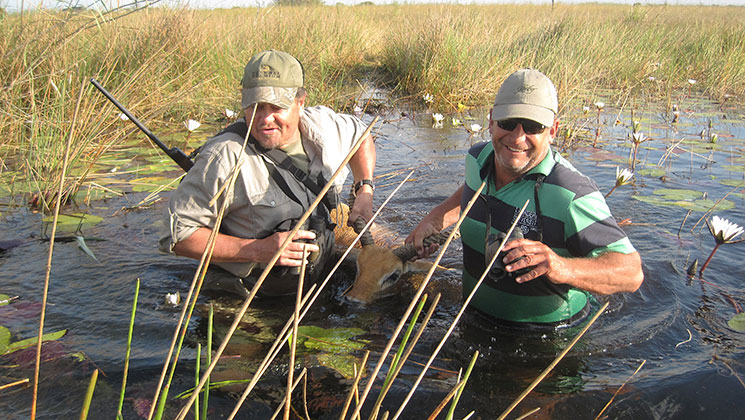
The Cuando River is loaded with fish. The one every fisherman seeks is the tigerfish with its fearsome maw and attitude, but we found they’re hard to come by when the river runs full just after the rainy season. As the sun retreated behind the thorn trees, Rick and I had plenty of action with the smaller but just as toothy African pike and the bass-like nembwe. Floating down the Cuando, we cast big spoons tight to the papyrus and cranked them across the current for vicious strikes. After a few smokes Oscar calmed down and smiled at the growing pile of fish, his meal for the night, but I could still see something that looked like worry around his eyes. He wanted to be off the river well before dark.
Our rifles were loaded and lay on the boat seats, but danger was almost an afterthought. Rick and I were having too much fun to worry about an angry hippo flipping our boat until Riaan shouted from the stern. We followed his pointing finger to a bulge in the current approaching us at an alarming rate. The closer the wave of water got to our boat, the higher it seemed to grow. And then, just a few yards from the gunwale, it disappeared. We squinted through the water to see a bull hippo that looked bigger than our boat pass beside us close enough to prod with an oar. Riaan gunned the engine. We had taken enough chances for one day—even in the Caprivi.













